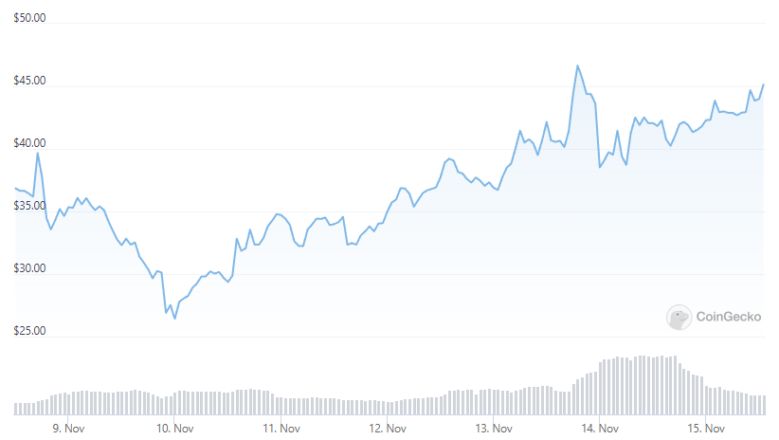Key Takeaways
- The decentralized futures platform GMX has seen an increase in use following the collapse of FTX.
- Last week, GMX registered a new all-time daily high trading volume of $1.17 billion.
- Other decentralized trading platforms, such as the Polygon-based Gains Network, have also increased in popularity.
Share this article
GMX trading volume has hit an all-time daily high of $1.17 billion in the wake of FTX’s collapse.
GMX Trading Volume Soars
Crypto traders are turning to DeFi following FTX’s implosion.
The decentralized futures trading platform GMX has soared in popularity over the past week due in no small part to the loss of trust in centralized exchanges. The DeFi protocol facilitates trustless leveraged trading using smart contracts rather than taking custody of users’ assets.
Over the past week, trading volume on GMX has registered a new daily high of $1.17 billion, per Dune data compiled by @saulius. The number of daily users also significantly increased, jumping to the highest level since June. The increased trading volume puts GMX in contention with many established centralized exchanges. For example, over the past 24 hours, the U.S.-based Kraken exchange has handled $737 million worth of transactions, while centralized futures exchange Bybit has seen just over $800 million in volume, per CoinGecko data.
The GMX protocol’s governance token has reacted positively to the increase in use. It’s up over 67% since the market crashed on November 10. Despite the current weakness in the crypto market, GMX is only 28% off its all-time high of $62.10 recorded in January. Bitcoin, meanwhile, is down 75% from its peak.


In addition to the surge in users and trading volume, GMX’s revenues have also soared. According to Crypto Fees data, the protocol has averaged $1.04 million in daily revenue over the past seven days. It’s currently the third most profitable crypto project behind Ethereum and Uniswap.
GMX lets users open long or short positions on Bitcoin, Ethereum, Chainlink, and Uniswap with up to 30 times leverage. Positions are collateralized by liquidity providers who earn trading and liquidation fees from traders. The protocol lives on the Ethereum Layer 2 network Arbitrum and Avalanche.
GMX is one of many decentralized trading platforms to see an increase in popularity since the FTX collapse. Gains Network, a decentralized leveraged trading platform on Polygon, has also seen its daily users and trading volumes soar. Gains Network’s GNS token has subsequently received a boost, jumping 50% from its weekly low.
Last week’s FTX implosion has once again highlighted the risk of trusting centralized entities to custody crypto assets. Given the option, it appears that many traders are migrating over to decentralized alternatives—moreso as fears that other centralized exchanges such as Crypto.com and Gate.io may also be facing liquidity issues do the rounds in crypto circles. Only time will tell if decentralized trading can win in the long run. But for the time being, protocols like GMX are enjoying the limelight.
Disclosure: At the time of writing this piece, the author owned ETH and several other crypto assets.
Share this article
The FTX Saga: Lessons We Knew But Didn’t Learn
After Do Kwon, Three Arrows Capital, and Alex Mashinsky set the standard for outrageous misbehavior in the crypto space this year, Sam Bankman-Fried’s spectacular fall from grace has recalled one…


What Crypto Winter? GMX Soars 34% on Binance Listing
GMX went live on Binance earlier today. GMX Jumps Amid Binance Hype One of crypto winter’s outperformers is benefiting from the Binance listing effect. Per CoinGecko data, GMX has jumped…


GMX Review: Is DeFi’s Buzzy 30x Leverage Exchange Easy to Use?
GMX users can “long” or “short” up to 30 times the size of their collateral by borrowing funds from a large liquidity pool. Decentralized Leverage GMX is a popular decentralized…


